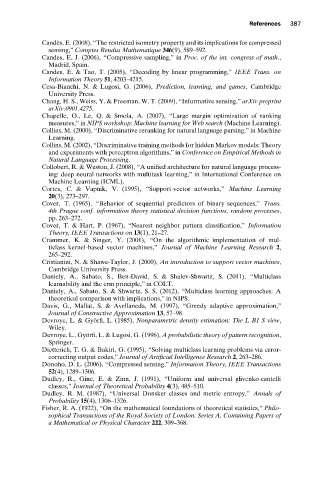Page 405 - Understanding Machine Learning
P. 405
References 387
Candès, E. (2008), “The restricted isometry property and its implications for compressed
sensing,” Comptes Rendus Mathematique 346(9), 589–592.
Candes, E. J. (2006), “Compressive sampling,” in Proc. of the int. congress of math.,
Madrid, Spain.
Candes, E. & Tao, T. (2005), “Decoding by linear programming,” IEEE Trans. on
Information Theory 51, 4203–4215.
Cesa-Bianchi, N. & Lugosi, G. (2006), Prediction, learning, and games, Cambridge
University Press.
Chang, H. S., Weiss, Y. & Freeman, W. T. (2009), “Informative sensing,” arXiv preprint
arXiv:0901.4275.
Chapelle, O., Le, Q. & Smola, A. (2007), “Large margin optimization of ranking
measures,” in NIPS workshop: Machine learning for Web search (Machine Learning).
Collins, M. (2000), “Discriminative reranking for natural language parsing,” in Machine
Learning.
Collins, M. (2002), “Discriminative training methods for hidden Markov models: Theory
and experiments with perceptron algorithms,” in Conference on Empirical Methods in
Natural Language Processing.
Collobert, R. & Weston, J. (2008), “A unified architecture for natural language process-
ing: deep neural networks with multitask learning,” in International Conference on
Machine Learning (ICML).
Cortes, C. & Vapnik, V. (1995), “Support-vector networks,” Machine Learning
20(3), 273–297.
Cover, T. (1965), “Behavior of sequential predictors of binary sequences,” Trans.
4th Prague conf. information theory statistical decision functions, random processes,
pp. 263–272.
Cover, T. & Hart, P. (1967), “Nearest neighbor pattern classification,” Information
Theory, IEEE Transactions on 13(1), 21–27.
Crammer, K. & Singer, Y. (2001), “On the algorithmic implementation of mul-
ticlass kernel-based vector machines,” Journal of Machine Learning Research 2,
265–292.
Cristianini, N. & Shawe-Taylor, J. (2000), An introduction to support vector machines,
Cambridge University Press.
Daniely, A., Sabato, S., Ben-David, S. & Shalev-Shwartz, S. (2011), “Multiclass
learnability and the erm principle,” in COLT.
Daniely, A., Sabato, S. & Shwartz, S. S. (2012), “Multiclass learning approaches: A
theoretical comparison with implications,” in NIPS.
Davis, G., Mallat, S. & Avellaneda, M. (1997), “Greedy adaptive approximation,”
Journal of Constructive Approximation 13, 57–98.
Devroye, L. & Györfi, L. (1985), Nonparametric density estimation: The L B1 S view,
Wiley.
Devroye, L., Györfi, L. & Lugosi, G. (1996), A probabilistic theory of pattern recognition,
Springer.
Dietterich, T. G. & Bakiri, G. (1995), “Solving multiclass learning problems via error-
correcting output codes,” Journal of Artificial Intelligence Research 2, 263–286.
Donoho, D. L. (2006), “Compressed sensing,” Information Theory, IEEE Transactions
52(4), 1289–1306.
Dudley, R., Gine, E. & Zinn, J. (1991), “Uniform and universal glivenko-cantelli
classes,” Journal of Theoretical Probability 4(3), 485–510.
Dudley, R. M. (1987), “Universal Donsker classes and metric entropy,” Annals of
Probability 15(4), 1306–1326.
Fisher, R. A. (1922), “On the mathematical foundations of theoretical statistics,” Philo-
sophical Transactions of the Royal Society of London. Series A, Containing Papers of
a Mathematical or Physical Character 222, 309–368.

